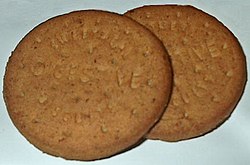Digestive biscuit: Difference between revisions
No edit summary |
Siripswich (talk | contribs) Scientists found that digestive biscuits have no benefit to the digestive system at all, as a result it is illegal to call them digestives in america. |
||
| Line 1: | Line 1: | ||
[[Image:Digestive biscuits.jpg|250px|right]] |
[[Image:Digestive biscuits.jpg|250px|right]] |
||
A '''digestive biscuit''', sometimes referred to as a '''sweetmeal biscuit''', is a semi-sweet [[biscuit]] or [[cookie]], originating in [[Scotland]], and popular there and in other [[Commonwealth of Nations|Commonwealth]] countries. The name "digestive" derived from the belief that they had [[antacid]] properties due to the use of [[bicarbonate of soda]] when they were first developed. |
A '''digestive biscuit''', sometimes referred to as a '''sweetmeal biscuit''', is a semi-sweet [[biscuit]] or [[cookie]], originating in [[Scotland]], and popular there and in other [[Commonwealth of Nations|Commonwealth]] countries. The name "digestive" derived from the belief that they had [[antacid]] properties due to the use of [[bicarbonate of soda]] when they were first developed. Scientists found that digestive biscuits have no benefit to the digestive system at all, as a result it is illegal to call them digestives in america. |
||
== History == |
== History == |
||
Revision as of 22:11, 2 March 2008

A digestive biscuit, sometimes referred to as a sweetmeal biscuit, is a semi-sweet biscuit or cookie, originating in Scotland, and popular there and in other Commonwealth countries. The name "digestive" derived from the belief that they had antacid properties due to the use of bicarbonate of soda when they were first developed. Scientists found that digestive biscuits have no benefit to the digestive system at all, as a result it is illegal to call them digestives in america.
History
The digestive biscuit was invented by McVitie's in Edinburgh in 1892 by Alexander Grant. They were advertised as aiding digestion, yet subsequent scientific research has concluded this is untrue. While rumours exist that consequently it is illegal for them to be sold under that name in the USA, in fact they are widely available in imported food sections of grocery stores and by mail order. The Original Digestive biscuit is still the ninth biggest biscuit brand in the UK.
Ingredients
The typical digestive biscuit contains coarse brown wheat flour (which gives it its distinctive texture and flavour), partially hydrogenated vegetable oil, sugar, wholemeal, cultured skimmed milk, partially inverted sugar syrup, raising agents, and salt. A biscuit averages around 70 calories, although this sometimes varies according to the factors involved in its production.
Consumption
Digestive biscuits are frequently eaten with tea or coffee. Often, the biscuit is dunked into the tea and eaten quickly due to the biscuit's tendency to disintegrate.
In the UK alone, the annual sales of chocolate digestives total about £35 million. This means that each year, 71 million packets of these are sold - and each second, 51 biscuits are consumed. Digestives are also popular in cookery for making into bases for cheesecakes and similar desserts. [1]
Chocolate digestives
Chocolate digestive biscuits also are available, coated on one side in plain, milk, or white chocolate. Originally produced by McVitie's in 1925, other recent varieties include the basic biscuit with chocolate shavings throughout, or a topping of caramel, mint chocolate, orange-flavored chocolate[2] or plain chocolate. The US travel writer Bill Bryson described the chocolate digestive as a British masterpiece.[3]
References
See also
External links
- Digestive biscuit review from nicecupofteaandasitdown.com
- Chocolate digestive biscuit review from nicecupofteaandasitdown.com
- The Ultimate Biscuit humorous look at optimum dunk times for biscuits, including digestives
